| . 1 . 2 . 3 . >> |
| Author |
Message |
ArkansasCabin
Member
|
# Posted: 26 Feb 2013 05:00am
Reply
Does anyone have any pictures of their propane lighting setup, or can help explain how propane lighting works with copper lines or black pipe lines?
I'm curious how the connections are made from the propane tank, fed into the lines and the whole 9 yards.
I was looking to add a few "mr heater base camp lights" to my cabin and am confused how the propane lights are even connected to the propane source.
I'm guessing its nothing like the connection on a twist on propane tank? or is it?
|
|
skootamattaschmidty
Member
|
# Posted: 26 Feb 2013 04:53pm
Reply
My cabin is almost entriely lit by propane lights with a few 12v led lights. I have 2 single lights and a double propane light as well as one installed outside on the front porch. My set up is pretty simple. I have a 100lb propane tank outside. Connected into the tank is the standard regulator and from that propane is fed into the cabin via 5/16" copper tubing. All the fittings, t's, etc are flared connections using a flaring tool and then brass fittings. The propane lights come with a standard fitting that the propane line easily screws into. The inside lights have been in place for many years and work great. I have attached a couple pictures for you so you can see how they are done. Hope this helps.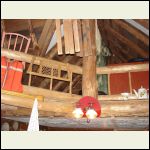
double light
| 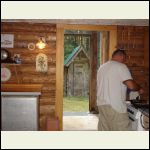
fall_and_semi_2009_0.jpg
| 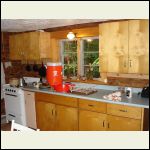
Pictures_026.jpg
|  |
|
|
skootamattaschmidty
Member
|
# Posted: 26 Feb 2013 05:01pm
Reply
Sorry I said 5/16" copper tubing but it's 3/8" tubing. Everything in the cabin runs off the main line in and is split from there. This includes lights, fridge, stove/oven, water heater and portable bbq on front porch. No pressure problems at all even when all appliances are running at the same time.
|
|
beachman
Member
|
# Posted: 26 Feb 2013 05:51pm
Reply
Skoota, I see where you have the Falks lights. I too have the same lighting and use 6 lights throughout my new camp and have three in my old camp. I hooked them up myself and in dealing with propane, you have to be meticulous with the connections. I also used 3/4 inch tubing. I also used this tubing for my fridge and older stove. Be careful not to kink or otherwise compromise the copper tubing. When joining the tubing to the lights, make sure you put the screw joiner on the tubing before you flare the tube. Then paste on little pipe sealer on the joining partsbpartsbefore you connect them. The flares have to be pretty exact to get a good seal. You'll know if you didn't. It will stink like hell when you turn on the gas.
|
|
skootamattaschmidty
Member
|
# Posted: 26 Feb 2013 06:17pm
Reply
Yes you must make sure to test all connections to ensure you have a tight seal. The best way to do this is with soapy water in a squirt bottle. Just squirt a small amount of the soapy water mix on each connection. Even if there is the tiniest leak it will start bubbling.
The Falks lights are great but are a little pricey. Not sure where you are from beachman but I'm in Ontario and they are about a hundred bucks each. I'm hoping to buy another double one this summer to make it a little brighter.
|
|
ArkansasCabin
Member
|
# Posted: 27 Feb 2013 02:10am
Reply
Thanks for the responses. Your lighting and cabin itself look really nice. (is the oven/range an rv one? or something from a menards or homedepot?)
Correct me if im wrong, but the copper tubing looks similar to the tubing that connects refridgerators to the water line, is that the same? or is there a specific type for the propane?
Thanks for all your help.
|
|
skootamattaschmidty
Member
|
# Posted: 27 Feb 2013 07:32am
Reply
The oven is not from an rv. It is propane and requires no electricity for pilot lights etc. My uncle bought it years ago before I bought the cottage off him so I'm not sure where he got it. I do believe it came from a propane appliance dealer in the Toronto area where he lived.
As far as the copper tubing goes, I believe it's the same tubing that can be used for propane and water and it's not specific to propane.
|
|
beachman
Member
|
# Posted: 27 Feb 2013 05:31pm
Reply
Scoota, I am in NB. The Falks lights run about $75 each for the singles and probably around $120 for the doubles. The newer tubing that I bought was coated with a yellow plastic - probably to prevent corrosion or discoloring. The local propane shop made me up a manifold from black pipe with several offshoots and shut-off valves. It works very well.
|
|
|
skootamattaschmidty
Member
|
# Posted: 27 Feb 2013 07:21pm
Reply
Thanks beachman. I was actually looking on line today and they range from $59 to $109 for the single lights.
The new copper tubing does have the yellow coating which I believe allows for use outside to bury etc. My father in law is a heating cooling guy and he ran me a propane line on the outside of the cabin underground to my front porch for the outside light and BBQ. He used the plastic coated copper to do so.
|
|
tcmatt
Member
|
# Posted: 27 Feb 2013 09:49pm
Reply
ArkansasCabin,
The connection to the tank is pretty easy. I just got a standard regulator to screw onto my 20lb tank and then went to the local hardware to match the end of the regulator. You'll need to get a flaring tool and practice a bit flaring the end.
hope this helps.
Matt
|
|
tcmatt
Member
|
# Posted: 27 Feb 2013 09:53pm
Reply
here's a few more pics of mine...i just put them in a few weeks ago.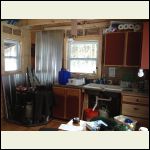
IMG_00941.JPG
| 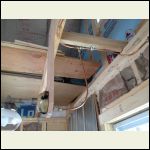
IMG_00921.JPG
| 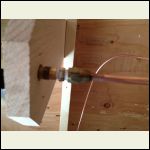
IMG_00891.JPG
|  |
|
|
ArkansasCabin
Member
|
# Posted: 27 Feb 2013 11:55pm
Reply
tcmatt,
thanks for those close ups. One of my concerns was the exact type of connection, and the picture shows me exactly what i will be working with. I didnt realize hooking the regulator up to the copper lines would be so "simple." It looks as if theres just a few connections, and with some practice with the flaring tool it should be do-able.
skootamattaschmidty,
by chance do you know where to get the copper tubing covered in the plastic? thanks in adance
|
|
Anonymous
|
# Posted: 28 Feb 2013 03:38am
Reply
Anybody know where I can get the Falk's online(U.S) for the best price?
|
|
skootamattaschmidty
Member
|
# Posted: 28 Feb 2013 06:01am
Reply
Being in Ontario you can get the copper tubing at most building supply stores like Home Depot. I assume its the same where you are. Or try a propane dealer or BBQ store.
As far as best price on the lights just google Falks lights. I was looking yesterday and there are a lot of dealers that carry them in the states, not so many in canada and the price varies from $59 to $109 plus shipping. So if you are lucky there may be a dealer close to you and you can avoid shipping costs. Here is a link to one sight that seemed ok. http://www.propaneproducts.com/catalog/indoor-gas-lights-1-1.html
Here is another place that had lots off of grid ideas. http://www.bensdiscountsupply.com/gaslights.aspx
|
|
tcmatt
Member
|
# Posted: 28 Feb 2013 08:38am
Reply
Arkansas,
my lights were old Humphries, I think, and had a 1/4" female hole. what you can't see in the close-up from the previous post is the double-ended male connector (behhind the oak mounting board). take a look at the photos. (i just found my bag of extras that I brought back). They show the sequence of parts that I used to go from the light to 5/16" tubing, which are...
light
double 1/4' male
double 1/4" female
1/4" male to 5/16" male flare-end.
what the picture below does not show is the female flared receiver (the photos from my previous post shows that piece.) Like Beachman said, put the receiver on before you flare the tube.
A couple of tips...
1. run more tubing than you think you need (like a couple of extra feet) between your connections. it's much easier to cut-off extra. not so easy to add a few inches.
2. make sure that the hose from your regulator is tight. Telfon tape or pipe sealer. The new regulator from the propane store had neither on it and I found out the hard way.
3. Use tape or sealer on all connections.
4. depending on the flaring tool, let the tubing stick through the flaring tool a couple of millimeters before flaring. having it flush on my tool, didn't work.
5. Keep your tank outside. mine is in right now, but after #2 above, I'm moving outside next time I'm at the cabin.
Matt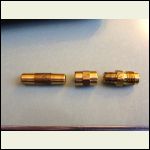
IMG_01231.JPG
| 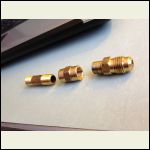
IMG_01241.JPG
|  |  |
|
|
Popeye
Member
|
# Posted: 28 Feb 2013 11:36am
Reply
Maybe it is a Canadian thing, but copper doesn't need a coating to be buried.
|
|
davey25
Member
|
# Posted: 28 Feb 2013 04:36pm
Reply
You don't need pipe dope if fittings are done properly but if you do you have to you must use pipe dope compatible with propane..and don't go by smell for leaks use leak check
|
|
Seth
Member
|
# Posted: 20 Sep 2014 02:24am
Reply
If anyone's still reading this thread:
I've recently found out that I won't get power at my cabin in Costa Rica for another year probably... so I'm thinking of propane lights. Homesteader friends gave me three Humphries that are still in the box, unopened. I've called some hardwear stores close to the village in CR and soft copper tubing seems to be impossible to get, so I'll be bringing it down from the states. I think I'll bring a Humphrey to Home Depot, find someone knowledgable, and buy everything I'll need (flaring tools, tubing, connectors, pipe sealer) to go from a propane tank to the lights, plus some extra mantles. I know I'll kick myself if I get all the way down there and have forgotten something crucial... Do any folks who use propane lights have any thoughts I might not think of?
|
|
tcmatt
Member
|
# Posted: 20 Sep 2014 06:45am - Edited by: tcmatt
Reply
When I did mine, I don't recall finding what I needed at Home Depot, but I did at my local Ace Hardware (just FYI).
I have redone every fitting on mine after an old friend with more experience had some suggestions. The biggest thing is not to use sealer or tape on any of the flare fittings. They do make a yellow pipe tape specifically for gas and I did use that going from the black pipe coming through the wall from the outside (that is connected) to the first copper fitting.
|
|
toyota_mdt_tech
Member
|
# Posted: 20 Sep 2014 10:10am - Edited by: toyota_mdt_tech
Reply
Pipe dope isnt needed if you are using a flare fitting. It is needed if you are using std pipe fittings, ie tapered threaded joints. When supporting the copper pipe, make sure the galvanized anchors have the rubber insert. You do not want any dissimilar metals in contact with the copper pipe, especially if its galvanized (the worst, you get what is called "galvanic corrosion") and it will eat holes right into and through the copper pipe. This is critical also when joining black steel pipe to copper (do not use galvanized) and usually, they will have bronze between the steel to copper, so it goes steel, bronze then copper. But you should be able to run all copper from tank to appliance. Secure the copper well near the tank so it wont move around. Copper can crack and break if its moved too much. Anchor it well, then use a rubber flexible whip hose to the tank. Make sure its rated for UV light etc. and inspect it annually for cracks.
The copper 3/8" stuff is available from home centers in rolls, usually 10, 25 and 50 feet. All the gas fittings, it flare, ferrule is in the gas piping section. This is usually a small area where all the smaller brass fittings are located. It is near the water plumbing. But they will have all the fittings you need.
I used double flares on all my ends, but we learned if its not "mobile" (in an earlier thread on this forum with help from Mt_Don) like a camp trailer, single flare is OK. There is also a ferrule flare, where the nut slides on, then the "bead" or ferrule slides over the copper pipe, then when its tightened down, the ferrule is crimped onto the copper pipe. The mate is different for flare fitting vs ferrule, so know what you need. Double flare is superior, if you have the tool (and I did) do it vs single for a free HD upgrade. 
There is a regulator at the tank, usually set to I am almost certain, 11lbs which drops the pressure and regulates, ie keeps pressure constant as more items are added or shut off. This is industry std for propane appliances.
|
|
Seth
Member
|
# Posted: 22 Sep 2014 01:31pm
Reply
Quoting: toyota_mdt_tech There is a regulator at the tank, usually set to I am almost certain, 11lbs which drops the pressure and regulates, ie keeps pressure constant as more items are added or shut off. This is industry std for propane appliances.
Thanks so much for your insight. A couple questions:
1. I'll only need these lights for a couple hours in the evenings. I'll also be cooking with a 3-burner propane range. In the village, only small (20#) propane tanks are available. Do you think I should run everything off of one small tank? Or keep the lights on a separate tank that I can just turn off during the day to save any possible leakage issues?
2. The 'regulator at the tank' that you mention - this is the chunky device at the beginning of propane hoses right? If so I believe I'll have to bring it/them with me.
Thanks again!
|
|
bldginsp
Member
|
# Posted: 22 Sep 2014 04:02pm
Reply
One thing that has not been mentioned in this thread is that you should do basic gas pipe sizing calcs to ensure that you aren't using pipe that is too small. If you tried to run 4 or 5 propane lights all stemmed off of one 3/8 pipe, you might not get enough supply to the lights, then they won't burn right. Also, very long lengths of pipe need to be increased in size to maintain capacity.
Gas pipe sizing is a little complicated but not rocket science, you can find pipe sizing charts on the web and instructions on how to do it. The danger is that if an appliance doesn't get proper gas pressure, it burns incorrectly and inefficiently and will produce carbon monoxide instead of carbon dioxide.
Correctly operating propane lights will produce mostly water and CO2, very little CO or other harmful gasses, so they are as safe as your kitchen stove if operating correctly.
|
|
Seth
Member
|
# Posted: 22 Sep 2014 06:00pm
Reply
Quoting: bldginsp Gas pipe sizing is a little complicated but not rocket science, you can find pipe sizing charts on the web and instructions on how to do it. The danger is that if an appliance doesn't get proper gas pressure, it burns incorrectly and inefficiently and will produce carbon monoxide instead of carbon dioxide.
Great info - thanks. I'll have three lights, and a max overall distance of 42 feet from the tank to the 3rd and final light.
I'm looking at these tables:
http://www.engineeringtoolbox.com/natural-gas-pipe-sizing-d_826.html
So I'm assuming copper type L, 3/8 nominal pipe size, 2,200 btu/hr for each Humphrey light resulting in 6.6 MBH full draw, so even at 80 feet I'd still have 7.4 MBH available... does that sound right to you?
|
|
bldginsp
Member
|
# Posted: 22 Sep 2014 06:11pm
Reply
I think you have the right idea but the link you gave is to natural gas pipe sizing. You need to find the propane chart at 11 inches water column, which (I think) is the standard pressure for small propane.
|
|
Seth
Member
|
# Posted: 22 Sep 2014 06:19pm
Reply
Quoting: bldginsp I think you have the right idea but the link you gave is to natural gas pipe sizing. You need to find the propane chart at 11 inches water column, which (I think) is the standard pressure for small propane.
I found this but don't quite understand how to factor in the water column stuff - this chart says it's for pressure less than 1 1/2 psig - is that meaningful? The chart says it's for low pressure propane lines. It'd give me 40 MBH at 40'.
http://www.engineeringtoolbox.com/propane-gas-pipe-sizing-d_827.html
|
|
bldginsp
Member
|
# Posted: 22 Sep 2014 06:37pm
Reply
Here's the chart you want-
http://www.engineeringtoolbox.com/propane-gas-pipe-sizing-d_827.html
So as you can see you are well within the range using about 7k btu at 40 feet or so with 3/8" copper. At 40 feet you could run 8 or 9 of those lights on a single 3/8" line, at least according to the chart.
So maybe the take-away is that so long as you have nothing else on the line in a small cabin, your lanterns are not going to out-capacity a 3/8" line so long as you have no more than 8 at 2.2k btu, but if you have any other appliances to operate like a stove, water heater, or direct vent heater, you are in another world and need hard pipe, 1/2" or 3/4", to those appliances.
Note though, that if you have other appliances on hard pipe, and you tie onto that hard pipe with a copper line for lanterns, then when you use the charts you should always use the distance column for the furthest appliance. So, the stove is 5 feet from the propane tank, the wall heater is 15 feet from the tank, but the lantern is 40 feet from the tank. When you do pipe size calcs for the hard pipe to the stove and heater, use the 40 foot column in the hard pipe chart. What this does is to protect the lantern (far away on a small pipe) when the other appliances are on.
One way to avoid complicated situations like this is to just carry the lantern pipe all the way back to the tank, not tapped off the hard pipe. Then the lantern is not affected by the use of the appliances on the hard pipe, so you can use a lower distance column when calcing your hard pipe.
|
|
Seth
Member
|
# Posted: 22 Sep 2014 06:40pm
Reply
Thanks, I appreciate your help!
|
|
bldginsp
Member
|
# Posted: 22 Sep 2014 06:42pm
Reply
We are posting simultaneously- yes, 11 inches water column is about 6 ounces psi, which is the standard used for recreational propane. There are higher pressure regulators for other applications, make sure you don't get one of those or your lantern will become a blow torch.
|
|
bldginsp
Member
|
# Posted: 22 Sep 2014 06:47pm
Reply
I think I should present the caveat that I'm not very experienced in propane installs- my experience is with residential natural gas- so there may be other factors here I'm unaware of, but at least we covered the basics of gas pipe sizing, which is a very important safety issue.
|
|
Seth
Member
|
# Posted: 22 Sep 2014 06:47pm
Reply
Quoting: bldginsp I think I should present the caveat that I'm not very experienced in propane installs- my experience is with residential natural gas- so there may be other factors here I'm unaware of, but at least we covered the basics of gas pipe sizing, which is a very important safety issue.
No worries - I appreciate the input.
|
|
| . 1 . 2 . 3 . >> |

